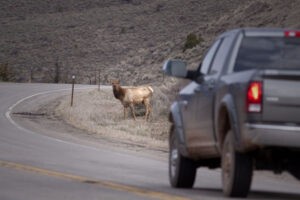
A roadside elk near Hoback Junction (photo Mark Gocke).
Have you had a chance to read the 2023 Teton County Annual Indicator Report? Being a science-based conservation organization, we love that Teton County created measurable, achievable goals to strive toward the Vision put forth in our Comprehensive Plan.
One of the indicators that the county looks at in its annual report is wildlife-vehicle collisions (WVCs). The county uses Jackson Hole Wildlife Foundation’s roadkill Nature Mapping data to look at annual changes, a three-year running average of changes and a five-year running average of changes in WVC. The goal is to keep county wide WVC below 206 (the level measured in 2012). From our last report, 165 WVC were reported in 2021, down from 220 the previous year. However, the running averages were both above 206, suggesting that there is still not a significant downward trend.
Despite this news, we expect the county trends to start changing more significantly over the next years to decade, as wildlife crossings are built and funnel fencing directs animals to crossings and keeps them off the road surface. WYDOT has begun construction on the WY 22-390 project which will build four wildlife underpasses and reduce WVC around that intersection. Additionally, Teton County is using some of the Wildlife Crossings Specific Purpose Excise Tax, “SPET”, dollars to have a consultant team (including a well-known road ecologist) create preliminary designs for mitigating three other WVC hotspot areas in the county.
Protecting our wildlife doesn’t always happen quickly, especially when it comes to projects as big as creating wildlife crossings, but patience can bring conservation rewards in due time. We are happy to have been part of this process throughout our 30-year history… we were founded on the goal of reducing wildlife roadkill in Teton County and we remain closely involved today!
